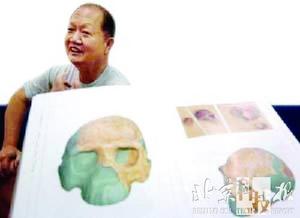Are Chinese descendants of an African Eve?
Is Nanjing Man the ancestor of the modern Chinese?
Xu Hankui, a researcher from the Nanjing Paleontology Institute, who discovered the fossil remains of Nanjing Man, also supports the hypothesis of multi-regional evolution. When fossilized skulls of Nanjing Man were discovered by peasants exploring an ancient lava cave, Nanjing Paleontology Institute sent several experts on a field trip. Xu was among them and participated in the study of the fossils.
 |
|
Xu Hankui shows the restoration of the skulls of Nanjing Man. |
Later, the Institute of Vertebrate Paleontology and Paleoanthropology showed that one of the skulls was of a 21 to 35-year-old women who lived 600,000 years ago and suffered from a bone disease called periostitis. She had many of the characteristics of Beijing Homo erectus, and genetic connections with other ancient Chinese human fossils. Another skull was from a male somewhere in the transitional phase between Homo erectus to Homo sapiens. There was gap of 100,000 years between the two skulls, and the finds showed evidence of continuous evolution of ancient Chinese human populations.
Xu Hankui believes that the Nanjing Man finds are evidence of multi-regional evolution.
The puzzle of Chinese people's shovel-shaped front teeth
One of the puzzles that the out-of-Africa theory needs to account for is the prevalence of shovel-shaped front teeth among the modern Chinese population. Dr. Xing Song says the distinctively-shaped teeth are prevalent in the Mongoloid race in East Asia. Licking their inside front teeth, Chinese people will find that there's a dent in their upper teeth while the surfaces of the lower ones are even. From the inside, the upper teeth look like shovels. According to Xing, these peculiarly shaped teeth were inherited in a continuous line from early Chinese hominids. About 80 percent of Chinese have such upper front teeth in contrast to only 5 percent of Europeans and 10 percent of Africans. Xing says this is strong evidence of the continuity of human evolution in China.
Moreover, hominid fossils in China share the same facial features: comparatively flat faces, a larger angle between the nose and the forehead, a flat nose bridge, rectangular eye sockets and forward-projecting cheekbones. All these features are absent in Africans.
Early Chinese lacked advanced stone technology seen in Africa. The stone artifacts unearthed in China also present difficulties for the out-of-Africa theory. In Palestine, archaeologists discovered stone artifacts from 100,000 years ago. These artifacts, very sophisticated and skillfully made, belong to the third phase of stone artifacts, much more advanced than the first and second phases. Palestine is an obvious route for African hominids to travel to the Eurasian Continent. If the geneticists are right, the African ancestors of the modern Chinese left Africa about 100,000 years ago, and passed through Palestine before reaching China some 60,000 years ago. Logically, the trekking Africans should have had the skills to make third phase stone artifacts when they arrived in China, and we would expect to find such artifacts.
But the fact is that the most basic stone artifacts, dating back 1.7 million years ago, were still in use on the Chinese mainland 30,000 years ago. About 98 percent of stone artifacts used by Chinese hominids belong to the "first phase." If migrating Africans were the ancestors of modern Chinese, why didn't they carry their advanced stone-working skills to China?
Huang Wanbo, a research fellow of the Institute of Vertebrate Paleontology and Paleoanthropology of Chinese Academy of Sciences, has been conducting paleoanthropological research for more than 20 years in the Three Gorges area. He says that just as the physical characteristics of East Asian hominid fossils can be traced back to a single origin, so can the artifacts of ancient East Asian cultures. For example, the "hand-axe" was one of the important African stone artifacts, dating back 1.7 million years. Most were made of obsidian formed by volcanic eruptions. In contrast, the ancient Chinese mostly used choppers and crushers made of quartz.
Gao Xing, another research fellow, echoed his colleague's opinion, saying that Chinese culture had developed continuously without interruption since remote antiquity and there was no sign that it had ever been replaced by foreign cultures.
 0
0 







Go to Forum >>0 Comments